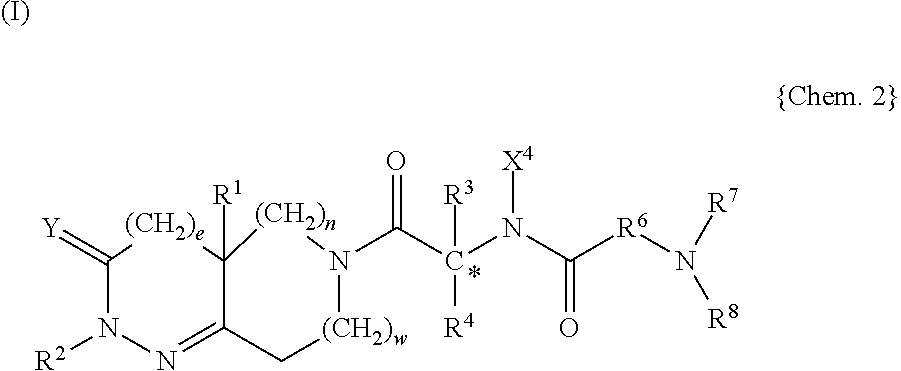Ghrelin receptor agonist for treatment of cachexia
a ghrelin receptor and cachexia technology, applied in the field of cachexia therapy agents, can solve the problems of no improvement in cachexia, no treatment encounter, and the severity of the treatment encounters a serious setback, so as to accelerate bone fracture repair, increase growth hormone secretion, and reduce food consumption and body weight.
- Summary
- Abstract
- Description
- Claims
- Application Information
AI Technical Summary
Benefits of technology
Problems solved by technology
Method used
Image
Examples
example 1
Inhibitory Effect on Weight Loss of Tumor-Bearing Mice
[0268]Tumor-bearing mice prepared using a murine colon cancer cell line, colon 26, are known to closely reproduce the symptoms of cancer cachexia (Cancer Research, 50, 4528-4532 (1990)). In this experiment, using tumor-bearing mice prepared using a murine colon cancer cell line, CT26, that was established in the same method as that for producing the murine colon cancer cell line, colon 26, (The Journal of Immunology, 154, 4685-4692 (1995)), Compound A of the present invention was evaluated for effects on the body weights of said mice. That is, CT26 colon cancer cells (5×106) were subcutaneously transplanted in the flank of BALB / c mice at 7 weeks of age. The transplanted mice were divided into two groups, and once every day from the following day of the transplantation, water for injection was orally administered to the control group, whereas Compound A was orally administered at a dose of 75 mg / kg to the compound administration g...
example 2
Inhibitory Effect on Weight Loss of Rats with Transplanted Cancer
[0273]Animals with transplanted cancer cells or cancer tissue exhibit weight loss and decrease in food consumption, and thus used as an animal model of cancer cachexia (“Endocrinology”, 148, 3004-3012, 2007). The effect of Compound A was examined using this model. Sarcoma cells induced by methylcholanthrene were subcutaneously injected into the abdomen of rats. The rats were reared in a normal environment for about eight days and in this way animals used to provide cancer were produced. An amount of 0.2 to 0.3 g of fresh cancer tissue obtained from the animals used to provide cancer was subcutaneously transplanted into the abdomen of rats under anesthesia. From 6 days to 7 days after the transplantation of the cancer, Compound A was administered once a day for 5 days to 14 days, and the body weight was daily measured. Compound A significantly inhibited the progression of the weight loss, which is an indicator for the d...
PUM
| Property | Measurement | Unit |
|---|---|---|
| temperature | aaaaa | aaaaa |
| temperature | aaaaa | aaaaa |
| volume | aaaaa | aaaaa |
Abstract
Description
Claims
Application Information
 Login to View More
Login to View More - R&D
- Intellectual Property
- Life Sciences
- Materials
- Tech Scout
- Unparalleled Data Quality
- Higher Quality Content
- 60% Fewer Hallucinations
Browse by: Latest US Patents, China's latest patents, Technical Efficacy Thesaurus, Application Domain, Technology Topic, Popular Technical Reports.
© 2025 PatSnap. All rights reserved.Legal|Privacy policy|Modern Slavery Act Transparency Statement|Sitemap|About US| Contact US: help@patsnap.com



